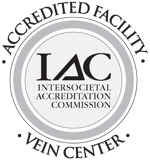Venous Reflux sounds like a title of an ominous science fiction novel. But this disease is real and quite common. Venous insufficiency is a chronic condition where there is inadequate return of blood from the veins in the leg back to the heart. The good news is that it is benign and treatable and something we are quite adept at handling at the Vein Institute of New Jersey.
What’s the Reflux?
Normal healthy leg veins have a series of valves which prevent blood from pooling in the legs while we are standing. Sometimes these tiny, one-way valves inside the veins weaken. In healthy veins, these valves push blood in one direction — back to our heart. When these valves become damaged, some blood flows backward and accumulates in the vein. Extra blood in the vein puts pressure on the walls of the vein. This pooling of blood creates surrounding pressure called reflux.
This reflux may result in enlarged blue, red or flesh-colored veins that can be seen through the skin. Over time, this can lead to other changes to the texture of the skin, and, potentially, leg ulcers, if not treated properly. With continued pressure, the vein walls weaken and bulge. Eventually, we can see varicose, spider or reticular veins.
10 Steps to Treat and Prevent Venous Reflux Disease
- Avoid long periods of standing or sitting: If you must take a long trip and will be sitting for a long time, flex and extend your legs, feet, and ankles about 10 times every 30 minutes to keep the blood flowing in the leg veins. If you need to stand for long periods of time, take frequent breaks to sit down and elevate your feet.
- Exercise regularly.Walking is especially beneficial.
- Stay hydrated. When you’ve had plenty of water, your blood is thinner and flows better. Thicker blood due to dehydration can make vein insufficiency problems worse.
- Eat healthy. Fruits and vegetables are great for circulation and the health of vein walls.
- Don’t smoke – please! The chemicals in tobacco smoke can deoxygenate and thicken blood. Additionally, nicotine causes vascular hardening and narrowing.
- Elevate your legs while sitting and lying down, with your legs elevated above the level of your heart.
- Reduce or avoid salt.Salt, or sodium, can cause the body to retain water. Excess fluid in the legs can cause swelling and put pressure on leg veins, weakening vein walls, leading to chronic venous insufficiency.
- Wear compression stockings. This helps reduce leg swelling and increase blood flow.
- Take antibiotics as needed to treat skin infections.
- Practice good skin hygiene. Though it doesn’t treat venous insufficiency, a daily application of moisturizer can heal dry or cracked skin, improving the health of your legs.
And if symptoms persist, we can utilize minimally-invasive techniques, such as ablation, to remove the underlying cause of venous insufficiency.
These minimally invasive techniques can be done using local anesthesia. With the guidance of an ultrasound, a very small needle is placed into the diseased vein. Through the needle a catheter is then threaded into the vein up to the level of the upper thigh. Using various forms of energy, the diseased vein is then closed off. A compression stocking is placed on the leg, and you can usually walk out of our office within half an hour after the procedure has been completed.
To talk further about Venous Reflux and general care of your legs, please schedule an appointment with us today.









.jpg?width=944&name=Castle-Connolly-Top-Doctors-Emblem-Large%20(4).jpg)